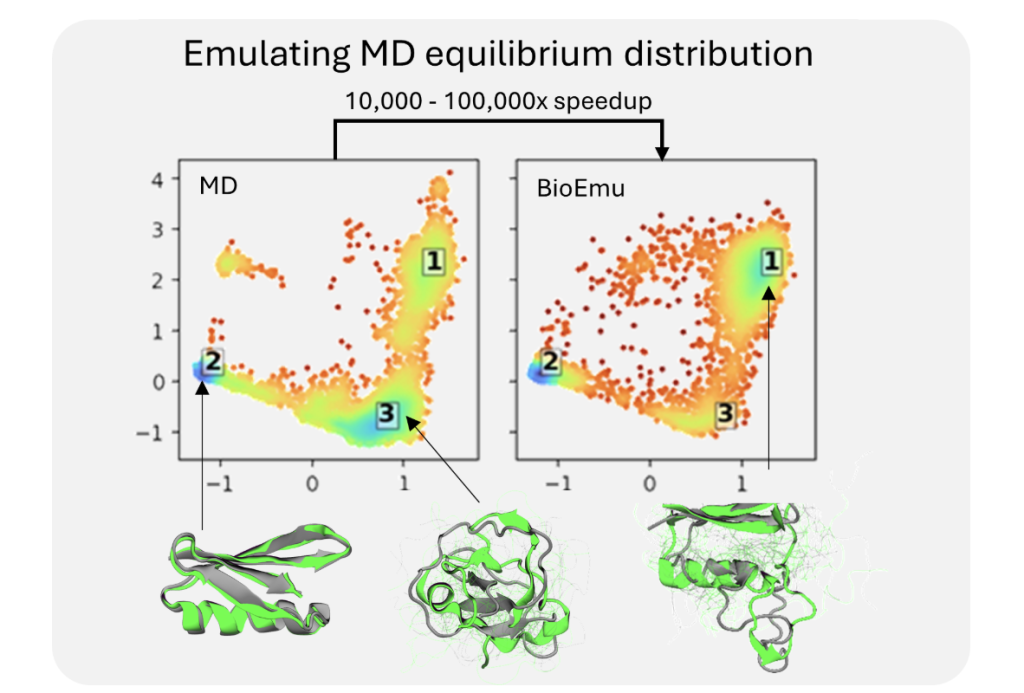

Proteins are the essential component behind nearly all biological processes, from catalyzing reactions to transmitting signals within cells. While advances like AlphaFold have transformed our ability to predict static protein structures, a fundamental challenge remains: understanding the dynamic behavior of proteins. Proteins naturally exist as ensembles of interchanging conformations that underpin their function. Traditional experimental techniques—such as cryo-electron microscopy or single-molecule studies—capture only snapshots of these motions and often require significant time and resources. Similarly, molecular dynamics (MD) simulations offer detailed insights into protein behavior over time but come at a high computational cost. The need for an efficient, accurate method to model protein dynamics is therefore critical, especially in areas like drug discovery and protein engineering where understanding these motions can lead to better design strategies.
Microsoft Researchers have introduced BioEmu-1, a deep learning model designed to generate thousands of protein structures per hour. Rather than relying solely on traditional MD simulations, BioEmu-1 employs a diffusion-based generative framework to emulate the equilibrium ensemble of protein conformations. The model combines data from static structural databases, extensive MD simulations, and experimental measurements of protein stability. This approach allows BioEmu-1 to produce a diverse set of protein structures, capturing both large-scale rearrangements and subtle conformational shifts. Importantly, the model generates these structures with a computational efficiency that makes it practical for everyday use, offering a new tool to study protein dynamics without overwhelming computational demands.
Technical Details
The core of BioEmu-1 lies in its integration of advanced deep learning techniques with well-established principles from protein biophysics. It begins by encoding a protein’s sequence using methods derived from the AlphaFold evoformer. This encoding is then processed through a denoising diffusion model that “reverses” a controlled noise process, thereby generating a range of plausible protein conformations. A key technical improvement is the use of a second-order integration scheme, which allows the model to reach high-fidelity outputs in fewer steps. This efficiency means that, on a single GPU, it is possible to generate up to 10,000 independent protein structures in a matter of minutes to hours, depending on protein size.
The model is carefully calibrated using a combination of heterogeneous data sources. By fine-tuning on both MD simulation data and experimental measurements of protein stability, BioEmu-1 is capable of estimating the relative free energies of different conformations with an accuracy that approaches experimental precision. This thoughtful integration of diverse data types not only improves the model’s reliability but also makes it adaptable to a wide range of proteins and conditions.

Results and Insights
BioEmu-1 has been evaluated through comparisons with traditional MD simulations and experimental benchmarks. The model has demonstrated its ability to capture a variety of protein conformational changes. For example, it accurately reproduces the open-close transitions of enzymes such as adenylate kinase, where the protein shifts between different functional states. It also effectively models more subtle changes, such as local unfolding events in proteins like Ras p21, which plays a key role in cell signaling. In addition, BioEmu-1 can reveal transient “cryptic” binding pockets that are often difficult to detect with conventional methods, offering a nuanced picture of protein surfaces that could inform drug design.
Quantitatively, the free energy landscapes generated by BioEmu-1 have shown a mean absolute error of less than 1 kcal/mol when compared to extensive MD simulations. Furthermore, the computational cost is significantly lower—often requiring less than a single GPU-hour for a typical experiment—compared to the thousands of GPU-hours sometimes necessary for MD simulations. These results suggest that BioEmu-1 can serve as an effective, efficient tool for exploring protein dynamics, providing insights that are both precise and accessible.

Conclusion
BioEmu-1 marks a meaningful advance in the computational study of protein dynamics. By combining diverse sources of data with a deep learning framework, it offers a practical method for generating detailed protein ensembles at a fraction of the cost and time of traditional MD simulations. This model not only enhances our understanding of how proteins change shape in response to various conditions but also supports more informed decision-making in drug discovery and protein engineering.
While BioEmu-1 currently focuses on single protein chains under specific conditions, its design lays the groundwork for future extensions. With additional data and further refinement, the model may eventually be adapted to handle more complex systems, such as membrane proteins or multi-protein complexes, and to incorporate additional environmental parameters. In its present form, BioEmu-1 provides a balanced and efficient tool for researchers, offering a deeper look into the subtle dynamics that govern protein function.
In summary, BioEmu-1 stands as a thoughtful integration of modern deep learning with traditional biophysical methods. It reflects a careful, measured approach to tackling a longstanding challenge in protein science and offers promising avenues for future research and practical applications.
Check out the Paper and Technical Details. All credit for this research goes to the researchers of this project. Also, feel free to follow us on Twitter and don’t forget to join our 80k+ ML SubReddit.
The post Microsoft Researchers Introduces BioEmu-1: A Deep Learning Model that can Generate Thousands of Protein Structures Per Hour on a Single GPU appeared first on MarkTechPost.
Source: Read MoreÂ





